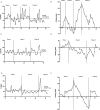Learning curve analysis of transvaginal natural orifice transluminal endoscopic surgery in treating ovarian cysts: a retrospective cohort study
- PMID: 39054512
- PMCID: PMC11270853
- DOI: 10.1186/s12905-024-03261-2
Learning curve analysis of transvaginal natural orifice transluminal endoscopic surgery in treating ovarian cysts: a retrospective cohort study
Abstract
Background: Transvaginal Natural Orifice Transluminal Endoscopy (vNOTES) is regarded as a challenging surgical technique to learn but is promising in reducing perioperative pain and significantly improves the cosmetic outcomes. Previous studies on the learning curve analysis of vNOTES mainly focuses on the hysterectomy approach, while the vNOTES ovarian cystectomy's learning curve was merely reported though more frequently performed than vNOTES hysterectomy. Therefore, this study seeks to analyze the learning curve of three surgeons with varying levels of experience in performing endoscopic surgery and vaginal surgeries for the treatment of ovarian cysts using vNOTES.
Methods: A total of 127 patients with ovarian cysts of a variety of pathological types were treated by ovarian vNOTES performed by three surgeons of different levels of endoscopic and transvaginal surgical experience. Each surgeon's learning curve was plotted using the Cumulative Sum method and divided into three or four phases of technique learning at the turning point of the learning curve. The sociodemographic and clinical features of patients in each phase were then compared and factors potentially associated with operation time were also screened.
Results: The learning curve was presented in four phases. The operation time (OT) was significantly shorter in phases II (53.66 ± 16.55 min) and IV (54.39 ± 23.45 min) as compared with phases I (68.74 ± 15.85) and III (75.93 ± 30.55) (p < 0.001). More cases of serve pelvic adhesion and endometrioma were assigned in the later phases. The OT of endometriotic cysts had much longer than that of non-endometriotic cysts(62.57 ± 18.64 min vs. 49.88 ± 14.26 min, p = 0.15) The presence of pelvic adhesion [adjusted odds ratio (OR) 7.149 (0.506, 13.792), p = 0.035] and bilateral cyst [adjusted OR 16.996 (2.155, 31.837), p = 0.025], max diameter of cyst[adjusted OR 2.799 (0.174, 5.425), p = 0.037], and individual surgeon [adjusted OR -6.118 (-11.814, -0.423), p = 0.035] were significantly associated with OT.
Conclusion: There learning curve of ovarian vNOTES has four phases. ovarian vNOTES could be mastered after performing seven, nine, and 16 cases by surgeons #1, 2 and 3 respectively, in gynecologic endoscopic surgeries.
Trial registration: ChiCTR2200059282 (Registered on April 28th, 2022).
Keywords: Cumulative sum analysis; Learning curve; Ovarian cystectomy; Transvaginal natural orifice transluminal endoscopic surgery.
© 2024. The Author(s).
Conflict of interest statement
The authors declare no competing interests.
Figures



Similar articles
-
Vaginal natural orifice transvaginal endoscopic surgery (vNOTES) for benign ovarian cysts is safe and feasible in same-day discharge: a retrospective cohort study.BMC Womens Health. 2024 Sep 14;24(1):514. doi: 10.1186/s12905-024-03352-0. BMC Womens Health. 2024. PMID: 39272028 Free PMC article.
-
Transvaginal natural orifice transluminal endoscopic surgery: a new approach to ovarian cystectomy.Fertil Steril. 2018 Feb;109(2):366. doi: 10.1016/j.fertnstert.2017.10.037. Epub 2017 Dec 13. Fertil Steril. 2018. PMID: 29246560
-
Learning curve analysis of transvaginal natural orifice transluminal endoscopic hysterectomy.BMC Surg. 2019 Jul 10;19(1):88. doi: 10.1186/s12893-019-0554-0. BMC Surg. 2019. PMID: 31291917 Free PMC article.
-
Transvaginal natural orifice transluminal endoscopic surgery (vNOTES) in gynecologic surgeries: A systematic review.Asian J Surg. 2020 Jan;43(1):44-51. doi: 10.1016/j.asjsur.2019.07.014. Epub 2019 Aug 20. Asian J Surg. 2020. PMID: 31444108
-
Hysterectomy Using Vaginal Natural Orifice Transluminal Endoscopic Surgery Compared with Classic Laparoscopic Hysterectomy: A New Advantageous Approach? A Systematic Review on Surgical Outcomes.Gynecol Obstet Invest. 2023;88(4):187-196. doi: 10.1159/000530797. Epub 2023 May 3. Gynecol Obstet Invest. 2023. PMID: 37231836
Cited by
-
Vaginal natural orifice transluminal endoscopic surgery for malignant ovarian tumors: a single-institution study.Arch Gynecol Obstet. 2025 Jun 6. doi: 10.1007/s00404-025-08080-w. Online ahead of print. Arch Gynecol Obstet. 2025. PMID: 40478319
-
Analysis of the learning curve for transvaginal natural orifice transluminal endoscopic surgery in ovarian cystectomy.Front Med (Lausanne). 2025 Jun 13;12:1629418. doi: 10.3389/fmed.2025.1629418. eCollection 2025. Front Med (Lausanne). 2025. PMID: 40584704 Free PMC article.
-
Vaginal Natural Orifice Transluminal Endoscopic Surgery (vNOTES) in Risk-Reducing Gynecologic Cancer Surgery: A New Frontier in Hereditary Cancer Prevention.J Clin Med. 2025 Jun 6;14(12):4018. doi: 10.3390/jcm14124018. J Clin Med. 2025. PMID: 40565763 Free PMC article. Review.
References
-
- Mandiwa C, Shen LJ, Tian YH, Song LL, Xu GQ, Yang SY, et al. Parity and risk of ovarian cysts: Cross-sectional evidence from the Dongfeng-Tongji cohort study. Journal of Huazhong University of Science and Technology Medical sciences = Huazhong ke ji da xue xue bao Yi xue Ying De wen ban = Huazhong keji daxue xuebao Yixue Yingdewen ban. 2016;36(5):767–71. 10.1007/s11596-016-1659-7.10.1007/s11596-016-1659-7 - DOI - PubMed
-
- Housmans S, Noori N, Kapurubandara S, Bosteels JJA, Cattani L, Alkatout I, et al. Systematic review and Meta-analysis on hysterectomy by Vaginal Natural Orifice Transluminal endoscopic surgery (vNOTES) compared to laparoscopic hysterectomy for Benign indications. J Clin Med. 2020;9(12). 10.3390/jcm9123959. - PMC - PubMed
MeSH terms
Grants and funding
- 2023352/Chengdu Municipal Medical Research Project in 2023
- 4408/Japan China Sasakawa Medical Fellowship Program
- 2021215/Chengdu High-level Key Clinical Specialty Construction Project, Chengdu Municipal Health Commission Project
- 2021215/Chengdu High-level Key Clinical Specialty Construction Project, Chengdu Municipal Health Commission Project
- 2021-YF05-00627-SN/Fifth Round of Chengdu Municipal Science and Technology Research Program
LinkOut - more resources
Full Text Sources
Medical
Miscellaneous

